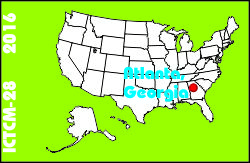
Electronic Proceedings of the Twenty-eighth Annual International Conference on Technology in Collegiate MathematicsAtlanta, Georgia, March 10-13, 2016Paper A028
Flipping, Clicking, and Group Activities in Business Calculus: Advice for Novices |
Bruce Pollack-JohnsonVillanova University bruce.pollack-johnson@villanova.edu list of all papers by this author |
| Click to access this paper: |
ABSTRACT
In the fall of 2015 I taught two sections of business calculus, one using a traditional lecture format and the other using a flipped classroom, with videos, midnight quizzes, clicker/peer instruction questions, and group activities. Students were assigned to each at random by the registrar, and they took the same pre and post tests and attitude surveys, as well as doing the same quizzes, tests, final exam, and semester-long project. I had hoped that students in the flipped class would do better on the conceptual quizzes and critical thinking, but the performance was similar in both classes (comparable to their pre-tests). The main difference between the classes was that the students in the flipped class spent significantly more time on the class compared to their time on other classes, and so they rated the efficient use of time lower than the control group. My major lesson from the experience was that creating top-notch clicker questions and group activities is just as time-consuming as making videos (which is very time-consuming), and they are the main reason for using the videos in the first place. If you are going to try to flip a class, it would be best to prepare most of the clicker questions and group activities (as well as most of the videos) before the class starts. If that is not possible, it might be better to add in excellent clicker questions and group activities a few at a time each iteration of the class, and make videos to make room for them if necessary, and build up the flipped class more organically. The paper also includes some other observations, lessons learned, and advice for anyone considering these teaching strategies for the first time.Keyword(s): calculus, applications
